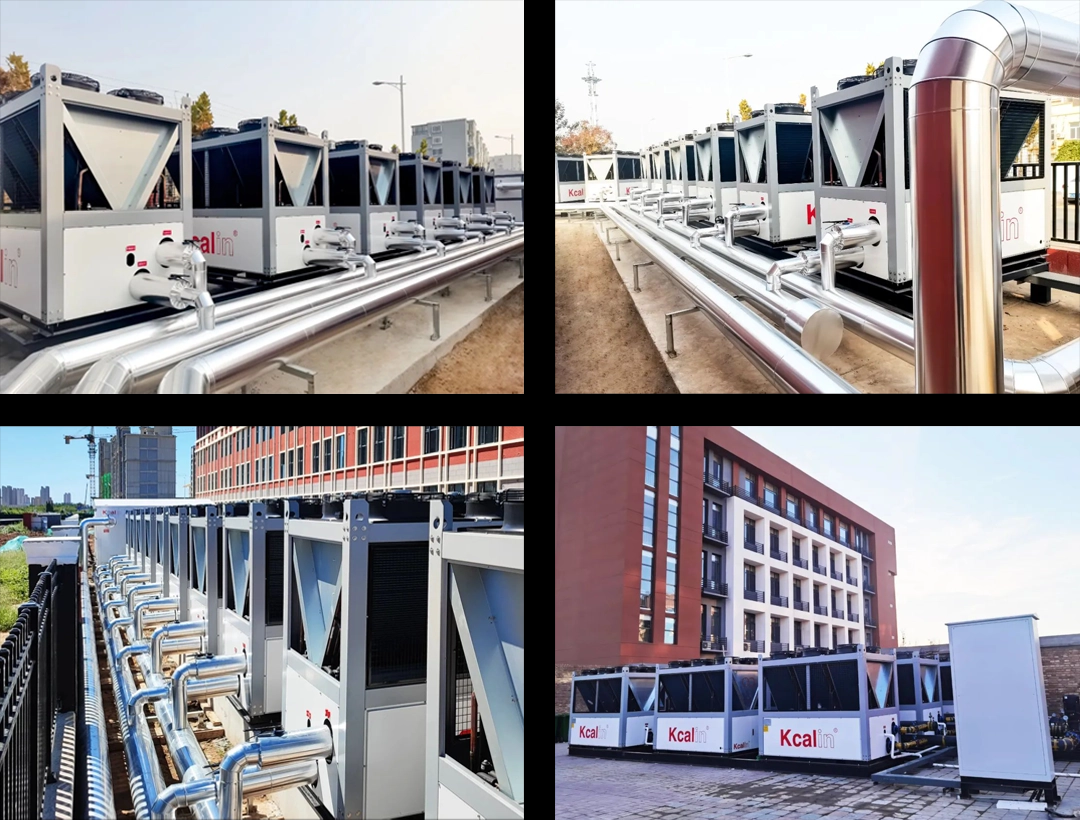With the increasing awareness of energy conservation and environmental protection, the application of heat pump technology in heating, cooling, and hot water supply is becoming increasingly widespread. Among many types of heat pumps, air-cooled heat pumps and air energy heat pumps have received much attention. However, many people are not clear about the difference between these two.
An air-cooled heat pump is a device that utilizes the heat energy in the air to achieve cooling and heating. It transfers heat from the outside air to the indoor environment or releases indoor heat to the outside world through heat exchange between outdoor air and refrigerant.
Its working principle is as follows:
Refrigeration mode: The air-cooled heat pump uses refrigerant to absorb indoor heat in the evaporator. After being pressurized by the compressor, the heat is released into the outdoor air in the condenser, achieving indoor cooling.
Heating mode: The air-cooled heat pump uses refrigerant to absorb heat from the outdoor air in the evaporator. After being pressurized by the compressor, the heat is released to the indoor environment in the condenser, achieving indoor heating.

Air source heat pump, also known as air source heat pump, is a device that utilizes the low-temperature heat energy in the air to be elevated to high-temperature heat energy through a compressor, in order to achieve heating, cooling, and hot water supply. Air energy heat pumps are mainly used in residential, commercial, and industrial fields.
Its working principle is similar to air-cooled heat pumps, but air energy heat pumps usually focus more on the heating effect in low-temperature environments:
Heating mode: The air energy heat pump absorbs low-temperature heat energy from the air, converts it into high-temperature heat energy through the thermal cycle of the refrigerant, and transfers it to the indoor environment.
Refrigeration mode: The air energy heat pump absorbs indoor heat and releases it outdoors through refrigerant circulation, achieving cooling.
The main differences between air-cooled heat pumps and air energy heat pumps
Working temperature range: The air-cooled heat pump is mainly designed for mild climate conditions, and its performance is good in the medium to high temperature range. Generally speaking, air-cooled heat pumps experience a decrease in performance when the outdoor temperature is low (such as below -5 ° C), making it difficult to work efficiently.
Air energy heat pumps are designed specifically for low-temperature environments and can operate efficiently even at lower outdoor temperatures (such as as as low as -15 ° C or even lower). Therefore, the heating effect of air energy heat pumps in cold areas is significantly better than that of air-cooled heat pumps.
Energy efficiency ratio: Energy efficiency ratio is an important indicator for measuring the performance of heat pumps, representing the amount of heat that can be output per unit of input electrical energy. In general, the COP of air energy heat pumps is higher than that of air-cooled heat pumps in low-temperature environments, which means that air energy heat pumps can provide more heat under the same electrical input.
Application scenario: Air cooled heat pumps are commonly used in air conditioning systems in mild climate areas, mainly for residential, commercial buildings, and some industrial refrigeration needs. It is easy to install, easy to maintain, and suitable for large-scale refrigeration and heating systems.
Air energy heat pumps are more commonly used in heating systems in cold regions, especially in scenarios where efficient heating still needs to be maintained under low temperature conditions. In addition, air energy heat pumps also perform well in hot water supply and are widely used in household water heaters, commercial water heaters, and industrial hot water supply systems.
Operating cost: Due to the high energy efficiency ratio of air-cooled heat pumps in low-temperature environments, their operating cost in cold regions is usually lower than that of air-cooled heat pumps. In milder climate conditions, the operating cost of air-cooled heat pumps may be slightly lower, but considering the annual usage, air energy heat pumps often have more economic advantages.
Environmental adaptability: Air cooled heat pumps are sensitive to changes in environmental temperature and their performance is easily affected by seasonal and climate changes. Therefore, when choosing air-cooled heat pumps, it is necessary to fully consider the local climate conditions.
Due to its superior low-temperature operating capability, air energy heat pumps perform well in cold regions and harsh weather conditions, and can provide stable and efficient heating and hot water services.
As two common heat pump technologies, air-cooled heat pumps and air energy heat pumps have their own functions and application scenarios. Air cooled heat pumps are suitable for mild climate conditions and are mainly used for cooling and heating; Air energy heat pumps perform well in cold climates and are particularly suitable for low-temperature heating and hot water supply.







Comment